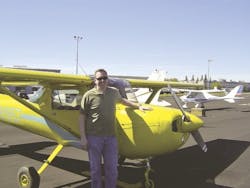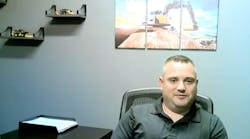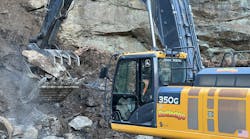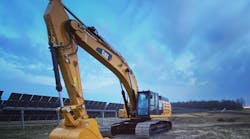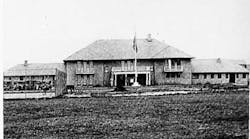In a 10-year career at heavy highway and general engineering contractor C.C. Myers, Inc., in Rancho Cordova, Calif., Under 40 in Construction Equipment Award winner Terrence McNamara made his mark. The 37-year-old rose from an assistant’s position in the executive office to Equipment Division manager, implementing change—and involving others—along the way.
Terrence is a licensed pilot. Read about how he applied his experience learning to fly to fleet management.
Though he recently moved to Teichert Construction in Sacramento, the changes he implemented at C.C. Myers endure. McNamara’s tenure included managing the first computer conversion in the company’s history, bringing in GPS technology, and launching a lease-versus-own model for the pickup fleet.
Like many in the new generation of managers, McNamara didn’t spend time as a technician, but he didn’t spend time as an accountant, either. His was a varied path.
“I came in as an assistant in the executive office to Mr. C.C. Myers, and to the president and CFO,” McNamara says. “From that I gained a lot of insight and knowledge to how the company ran as a whole.”
McNamara represented the executives in various meetings and also served as the company’s recruiting manager for a time. “I would go to colleges and universities and try to convince college students to come work for us,” he says. “It was a PR kind of thing at that time, too. I usually recruited for engineering and construction management, but it was occasionally broader than that, including business and accounting.”
At the same time, the company had a few high-profile jobs that thrust McNamara into the spotlight. “I got to be involved in the public relations and media campaigns for those jobs. One of them was the 17-day rebuild of the MacArthur Maze [interchange after a fuel tanker fire], and in the same year, we had a revolutionary construction project where we shut down an entire direction of a freeway in downtown Sacramento for a month.”
In a relatively short time, McNamara found himself familiar with the executive workings of the business, the recruitment of different disciplines, the ins-and-outs of complicated construction projects, and the public image of the company. It became time to test his knowledge and leadership ability on a specific and far-reaching project in IT.
“Our company then looked at and purchased an ERP software package, and I led the team that selected it and the team that implemented it,” McNamara says. “So that was another opportunity to learn a lot about the company as a whole, how the different parts fit together and interact, and the methodologies behind the running of the construction business.”
He also found he didn’t necessarily need to be a software pro.
“I’m not an IT expert, just like I’m not a mechanic,” McNamara says, “but it’s a business that could run like a profit center inside the company. Maybe you’re not going to get revenue from it, or maybe you can charge the jobs for your services and what you’re providing. If you step back and think about it like it’s a contract company that’s been brought in to provide IT services to this company, then you come at it in a different way.
“We had a department that was like a Dilbert cartoon, and it was a struggle between the people in the field and the people providing the IT services: The field would want something and there would be a reason why they couldn’t have it, instead of finding some workable solution in the middle,” McNamara says.
“We wrote a mission statement a few months in, and one of the key parts was that the IT department was going to provide services to the field on their terms, meaning the field’s terms—not when it was convenient to the people in the IT department,” McNamara says.
Putting that to practice involved recognizing some simple realities. For example, field personnel start work at 6 or 7 a.m. Those working in office environments generally get to work at 8 or 9 a.m. That meant there could be a problem in the field for two hours before any response. “We also started having equipment on the shelves that we could swap out if something went down,” McNamara says.
“We had an electronic time card system going at the time, and everybody in the company was using it. If you’re a foreman and you’ve got five or 10 people working for you, and it’s your responsibility to make sure their time card gets in the computer and your computer is broken, what are you going to do? So, we would have computers available for them to use, or we would have kiosks available at a job site where they could go and put their time in.”
McNamara made sure to involve people from every part of the company in the ERP implementation. “We asked what they needed,” he says. “It’s not ‘Here is your process,’ but ‘What is your process?’ It was really interactive. And when we did training, we didn’t have everyone all over California drop what they were doing and come to Sacramento. We went to job sites and where the people were to try to make it as easy as possible for them to get what they needed.”
McNamara thinks that helped lead to his move to the Equipment Division in late 2011.
“I think one of the reasons that I was selected for the equipment group was to do some of those same things and turn it into more of a service organization than just a resource provider,” he says. “To become a partner in the operations of construction as opposed to a vendor you just call when you need something.”
As with the IT transition, McNamara stresses it’s important to be careful not to dictate to the departments you serve.
“For instance, a field person will say ‘I need machine X,’ and [fleet] will go, ‘Well, you really need machine Y and that’s what we’re going to give you,’” McNamara says. “That creates tension, distrust, and all kinds of other things that are not good for construction.”
After ascending to equipment manager, McNamara worked to streamline the division and run it as if it were its own business inside the company. He wasn’t an equipment expert, but a family background in cars, trucks and race cars gave him some mechanical inclination.
“Not to oversimplify, but I knew it [equipment] was big and yellow,” McNamara jokes. “But at the end of the day, it’s just a business and equipment is the commodity. I don’t need to know how to change a V-drive belt, I need to have a guy who knows how to do that. I need to know why we’re doing it, and what it’s going to cost us, and what the benefit is of doing it. I think the old days of a mechanic coming up to be the guy running the division and making the decisions—with the amount of information and technology that we have now in construction equipment—I think that’s changed dramatically.”
One of the things McNamara changed while equipment manager was instituting the company’s first use of GPS tracking to follow assets and with that, the use of security measures to reduce losses from theft and vandalism.
The company’s fleet has approximately 200 trucks and on-road vehicles, 100 pieces of heavy iron, and 250 to 300 towable items, such as generators, compressors, message boards and light towers.
“Often in construction there’s a relationship with equipment that’s sometimes more emotional than mental,” McNamara says. “And when people have work to perform, and they know they have work to perform, they want to have the tools for that close at hand when they need them. The struggle for the company is that that may not be the best thing, because it’s not getting the utilization that it needs.
“Where the GPS really helped us early on was to be able to say this piece of equipment is or is not getting used as much as you say you need it—or as much as it should be used. It’s helped with our buy-sell decisions,” McNamara says.
“Sure, we get meter readings; well those are monthly or weekly, or whatever they are, and with a meter reading you’re looking at a window of time where they may have absolutely needed the equipment for a week of that month, but the rest of the time they didn’t,” he says. “The GPS brings that information out, because it tells us when the piece of equipment is running and not running.”
McNamara reports that GPS also helped with utilization decisions and increased accuracy in charging projects the proper number of hours for equipment use. “We would get swings prior to GPS,” he says. “Sometimes we’d get too many hours from the jobs, sometimes we wouldn’t get enough. And it really helped flatten that out both ways to make things more fair and predictable.”
The last big initiative McNamara worked on for the company was the replacement of its truck fleet, beginning a three-year program.
“The company has always owned their pickup truck fleet outright; we’ve shifted that to a leased-vehicle scenario with an operating lease,” McNamara says. “The second piece of the program is a maintenance plan from the lease provider that has scheduled maintenance included for a fee. The eventual goal is that the trucks will manage themselves, but we haven’t reached a critical mass with them yet where you can really say we’ve done something that’s eliminated a bunch of other costs or the need for other resources. We’ve only just finished the first year and 40 to 50 trucks. So far, the overall reception has been positive, the administration of the leased trucks is very easy, it takes it off of our plate, and we’re able to do other things,” McNamara says.
“There’s roadside assistance included, a 1-800 number for the driver to call. Trucks don’t break down between 7 and 4, they break down when the guy’s on the way home. We’re on the way home, too, so now we’re scrambling to find a tow truck. It’s completely taken that aspect off of our plates,” he says. “Leasing itself right now is a break-even proposition because of the way the lease is structured. I think as the vehicles cycle, if you came back and asked that question in six or eight years, it will have saved a lot.”
With every major move McNamara made at C.C. Myers, he sought out not only executive-suite buy-in, but also input from the departments and the people affected. That’s one thing he wants to point out to first-time equipment managers.
“You need the advice of the experienced people, even when you are creating new ways to do things,” he says. “I had a couple of people who were involved with me early on who were with the company for between 20 and 35 years. Not tech-savvy, not accountants, not [Construction Equipment contributing editor Mike] Vorster line-and-graph people. They had a lot of gut instinct, a lot of experience, a lot of ‘I’ve seen that before,’ that I didn’t have. It’s almost like a reality check: You’re doing all these things to run the business part of it, sitting in an office, when they’ve spent 30 years running the operational part of it, next to the piece of equipment you’re analyzing. They probably know something that you don’t. You know something that they don’t. All of this information is useful and necessary to make the right decision.”
McNamara’s approach to change is just as wise. “My goal is change and making things better. I come into work thinking ‘What can I improve today?’ Maybe not for me or my group, but what can I make better or easier for the company as a whole?”
